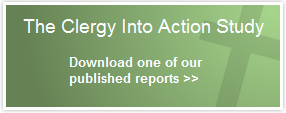The Pattern of Clergy Confidence
Let’s begin by exploring how new pastors and priests see themselves.
We asked more than 300 clergy who had participated in Transition into Ministry (TiM) programs to rate their confidence on 92 specific job-related tasks and activities that are part of ordained parish ministry, on a scale of 1 to 4. We did not tell them that these specific activities were each categorized into one of the broader 13 areas of ministry used elsewhere in the survey.
The respondents reported having the most confidence in work related to preaching and proclamation, being a role model, and sacramental and liturgical ministries. Their confidence in communication and self-development were also relatively high.
New clergy reported the lowest confidence in community outreach and connection, organizational leadership, and congregational and group development. They also indicate relatively weak confidence in lay ministry and leadership development, objective-setting and program planning, and supervision—as well as some forms of pastoral care.
Looking at the questions with the highest and lowest confidence ratings gives some deeper insight. The highest rated items had to do with communicating with integrity and commitment in sermons, making church services beautiful, ministry at funerals, leading a life exemplary of stability and self-discipline, empathic listening, and building trust.
The lowest rated items had to do with personal time management, developing and empowering lay leaders for educational ministry and facilities management, managing and mediating conflict, confronting destructive behavior, visiting lapsed members and visitors, assessing problems from a systemic perspective, working with groups to develop long-term goals and plans, fund-raising and financial record-keeping, focusing interests and attention and mobilizing people to address challenges in the broader community, collaboration with other churches and faith communities, and starting a new congregation.
The pattern in responses suggests that clergy are most confident in tasks that pull on their abilities to be kind, benevolent, understanding, steady, and religiously expressive, in settings that involve less risk. They are least confident in tasks that require more assertiveness and decisive direction, systemic thinking, formation of partnerships for leadership, and engagement with people beyond the walls of the local church or denomination.
In a nationwide study of Episcopal clergy conducted more than a decade ago, researchers John Dreibelbis and David Gortner found a consistent pattern of what they called “talented but tenuous”: highly creative people nonetheless lacking in self-confidence and decisiveness, who can come up with wonderful ideas but have neither the skill nor the will (nor feel the permission) to help communities bring ideas to fruition.1
They are kind, thoughtful, dedicated, considerate of others’ thoughts and feelings, and full of ideal visions of what the Church could be; but they are also conflict-averse, anxious about and watchful for opposition (and uncertain how to manage their own anxiety), and unclear about the nature of human systems and organizations.
Our analysis of data on clergy self-confidence gathered as part of the Clergy Into Action Study reflects this pattern of “talented but tenuous” individuals. It sketches out an interesting profile of how the newly ordained see themselves—but how do others see them?
We asked the TiM-supported clergy in our study to identify four individuals from their current ministry who might participate in a 360-style assessment of their abilities. Approximately 520 supervisors, mentors, colleagues in ordained ministry, lay leaders, employees, and volunteers responded to our questions.
We asked them to rate the new pastor or priest on the same 13 areas of ministry, and the responses skewed extremely positive. They seemed very hesitant to give their acquaintances any negative assessments. For the lowest-rated area of ministry, supervising others and work, less than 1% indicated the recently ordained subject “does not show much skill” and only 6% chose “shows some but intermittent skill.”
However, when we used the 360-assessment responses to rank the subjects’ strengths relative to each other, the familiar pattern reappeared. At the top was sacramental and liturgical ministries—nearly half of survey respondents indicated this was an area in which their recently ordained acquaintance showed exceptional skills.
The survey respondents also rated the subjects very highly in the areas of Christian education, being a role model, preaching and proclamation, and pastoral care. At the bottom of the list were supervising others, developing lay leadership and ministry, organizational leadership, and congregational/group development.
These responses confirm that we are seeing patterns of real strengths and weaknesses among inexperienced pastors and priests. The issue is not simply that the newly ordained themselves feel untrained and insecure about areas such as supervision and developing lay leadership—people who know them and have worked with them identify the same areas of weakness.
The predictability of these patterns of self-confidence (or lack of confidence) raise some key questions for us:
What are the consequences of these strengths and weaknesses? Do they affect how much time new clergy spend on different areas of ministry? And why are these patterns of strengths and weaknesses so persistent?
For Your Consideration
- Reflect on your own strengths and weaknesses in ministry. How might you go about developing more competence and confidence in some of your areas of weakness?
Continue Reading . . .
- Next Article: Which areas of ministry new pastors and priests prioritize in their time use
- Previous Article: Overview of study findings—Clear pattern emerges of emphasis on traditional clergy roles
1 John Dreibelbis and David Gortner, Talented but Tenuous: A Profile of Clergy Temperaments and Leadership Skills, research report submitted to the Lilly Endowment (Evanston, IL: Seabury-Western Theological Seminary, 2002).






